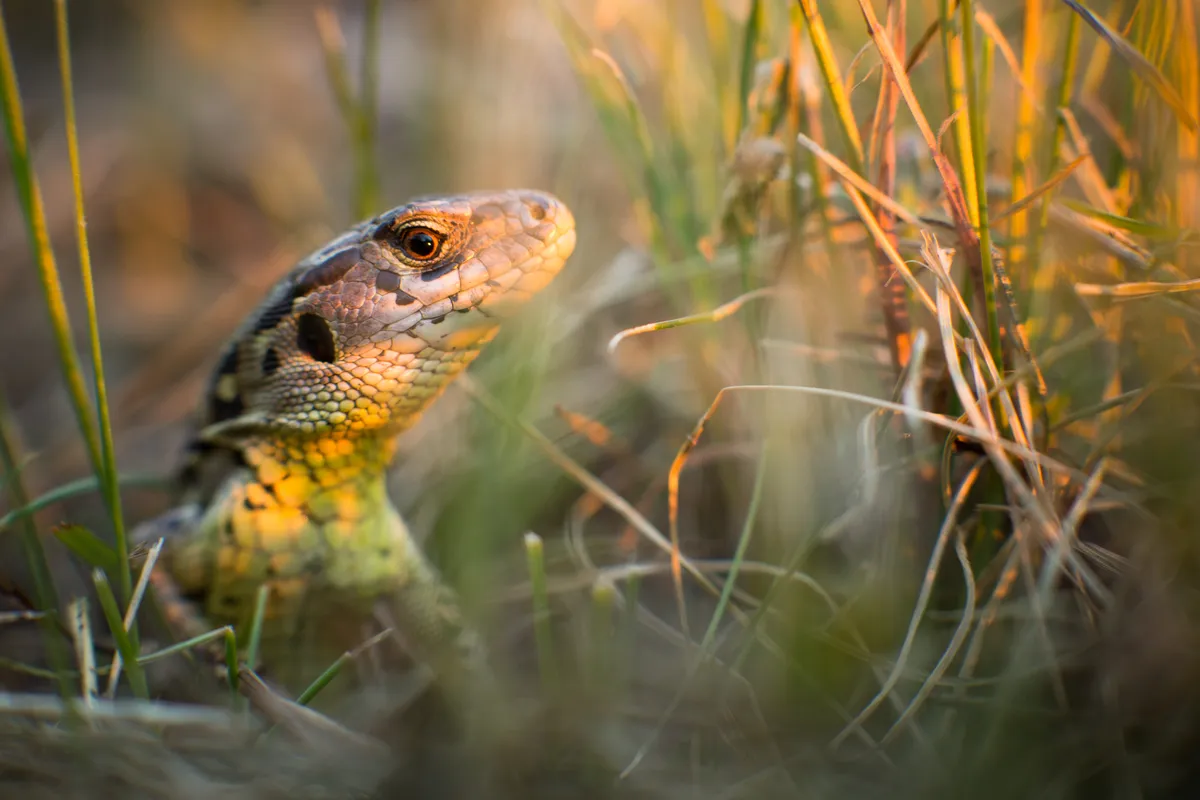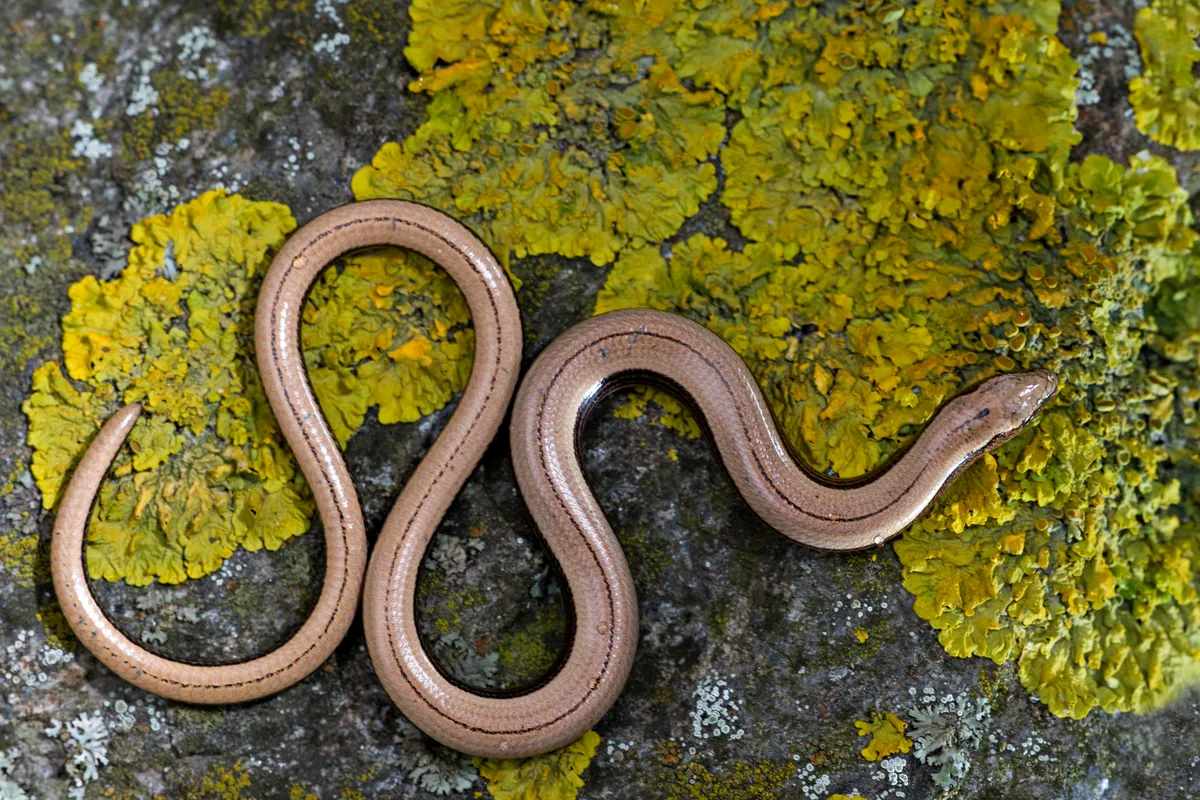Despite its appearance, the slow worm is not a snake (or a worm) but a legless lizard. This is apparent by the fact that it has eyelids (unlike snakes that have an unblinking eye) and a flat tongue. The slow worm can also detach its tail like other lizards to avoid predation.
Their similarity to snakes has led to their historic persecution. Often known as ‘blind worms’ (likely due to the small size of the eyes), they were killed alongside adders and grass snakes with little apparent discretion between species. Even Shakespeare portrayed them as venomous serpents – the witches in MacBeth creating potions with the ‘blind-worm’s sting’.
In reality, the slow worm is placid in temperament and largely tolerant of human behaviour.
In this guide, we take a closer look at slow worms in the UK, revealing information on how to identify them, where they live and what they eat.
Interested in learning more about British wildlife? Check out our guides to snakes, frogs and toads, and deer.
Reptiles of the British Isles
Discover the fascinating world of snakes, lizards and slow worms with BBC Countryfile Magazine's guide to Britain's six native reptiles.

What is a slow worm?
Perhaps the most remarkable attribute of a slow worm – Anguis fragilis – is its longevity.
The oldest specimen recorded in captivity lived for at least 54 years, so an adult in the wild may be more than 25 years of age.
A slow worm is a placid creature though, and of no threat to humans or pets. Instead, with a quiet approach, encounters can be treasured
Why is a slow worm not a snake?
A fondness for burrowing into loose soil and nosing through dense cover or long grasses has made the use of legs redundant, but the presence of bony plates called osteoderms beneath the scales hinders their ability to slither with great speed or ease. Instead, they rely on camouflage or, more usually, the use of cover.
Slow worms are cold-blooded but rarely bask in direct sunlight, preferring to hide beneath logs or rocks or within rotting vegetation where they take warmth from their surroundings.
The slow worm sheds its skin in parts and will leave a ‘roll’ rather than a complete skin as a snake will.
The tongue is dark and shorter than that of a snake with a notch at the end rather than a deep fork.
How to identify a slow worm
Females are normally dark brown, with dark stripes along the sides and sometimes a thin line along the back, whereas the paler males develop blue spots that are vivid in spring when they are looking to breed.
Both sexes grow to a length of around 50cm and the scales are smooth and dry to the touch.
The juveniles, born in late summer, glow bronze as if freshly minted.

Slow worm behaviour
Unlike other British lizard species, the slow worm tends not to bask in direct sunlight, preferring instead to raise its body temperature by lying beneath objects or within rotting plant matter such as compost.
What do slow worm eggs look like?
Slow worms are ovoviviparous, which means that they hatch from eggs while still inside the body. This method is advantageous in a cooler climate as the female is able to better regulate the temperature of the young as they develop, whereas egg-laying reptiles such as grass snakes and sand lizards are limited in their British range by the climate.
Spring is the mating season for slow worms and can spark less docile behaviour than might usually be associated with the slow worm.
During a process that may last several hours, the male will grab the female’s head or neck in its mouth as the two copulate – a behaviour familiar in other lizard species.
The female may subsequently carry the scars of conception as she carries the developing embryos.
What do slow worms eat?
Slugs and snails make up a large proportion of a slow worm’s diet, so avoid the use of slug pellets or chemical fertilisers and insecticides. They also eat invertebrates such as worms and spiders.
By attracting greater invertebrate diversity, you will provide food for slow worms and other animals such as hedgehogs.
Slow worm habitat
Despite their rather secretive existence, slow worms are probably the most frequently encountered British reptile.
They are often found in gardens and may also be found beneath pieces of corrugated iron and can be encouraged into gardens by providing refugia for them.
They are liked by gardeners due to their fondness for slugs, although they are susceptible to predation from domestic cats.
As with other lizard species, the slow worm is reliant upon camouflage and will tend to remain still if discovered.

How to find a slow worm
Slow worms will often bury themselves in compost or leaf piles, so be watchful whenever turning or removing compost.
Placing a square of old carpet or rubber car mat on top of the pile will offer slow worms a place to shelter and let you know if any are about.
A tendency to stay still if discovered enables us to get a close-up view.
Care should be taken when grass cutting as slow worms will not always be quick enough to evade the blades of a mower.
Scan an area before beginning a cut and try to leave lawn edges or specific areas long. Slow worms enjoy the safety of deep, dense grass.
